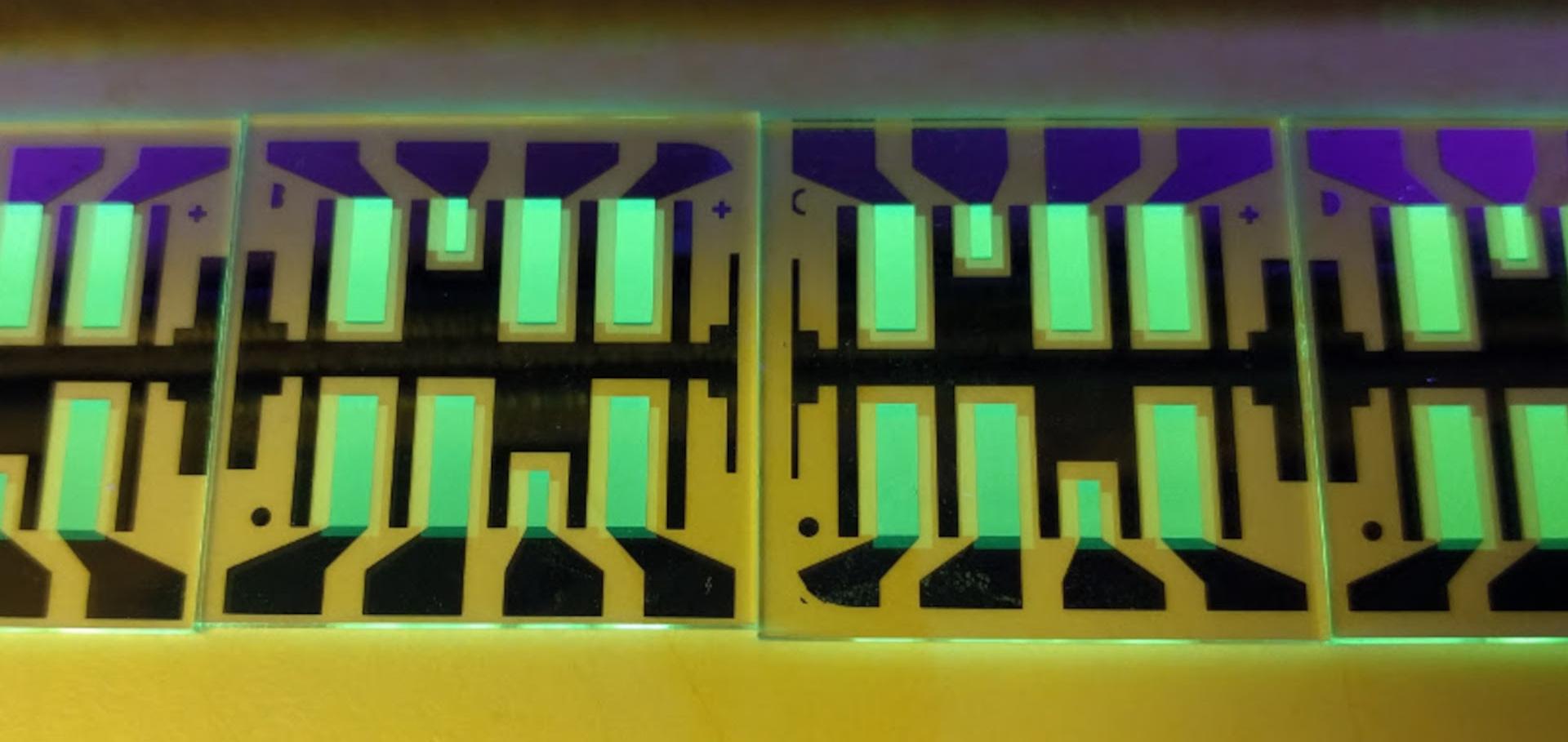The effect of barrier performance on the lifetime of small-molecule organic solar cells
Solar Energy Materials and Solar Cells 97 (2012) 102-108
Abstract:
In this work, we use different encapsulations to protect vacuum-evaporated small molecule organic solar cells with a simple p-i-i-stack for lifetime studies. Our devices use ZnPc and C60 as active materials. Lifetimes (T50) in a range from 300 h for un-encapsulated devices to 4000 h for glass-encapsulated have been observed. We use a model to distinguish between the water vapor transmission rate (WVTR) of the barrier and an additional WVTR of the aluminum top electrode. For all observed devices a loss of 50% of initial efficiency is observed when 10 mg m-2 water entered the device. The losses are related to a reduction of short circuit current density only, whereas open circuit voltage and fill factor remains unaffected. We relate this to an interaction of the water molecules with C60. © 2011 Elsevier B.V.Effect of film thickness, type of buffer layer, and substrate temperature on the morphology of dicyanovinyl-substituted sexithiophene films
Thin Solid Films 520:7 (2012) 2479-2487
Abstract:
The influence of film thickness, type of buffer underlayer, and deposition substrate temperature on the crystal structure, microstructure, and morphology of the films of dicyanovinyl-substituted sexithiophene with four butyl-chains (DCV6T-Bu 4) is investigated by means of X-ray diffraction (XRD) and X-ray reflectivity methods. A neat Si wafer or a Si wafer covered by a 15 nm buffer underlayer of fullerene C 60 or 9,9-Bis[4-(N,N-bis-biphenyl-4- yl-amino)phenyl]-9H-fluorene (BPAPF) is used as a substrate. The crystalline nature and ordered molecular arrangement of the films are recorded down to 6 nm film thickness. By using substrates heated up to 90 °C during the film deposition, the size of the DCV6T-Bu 4 crystallites in direction perpendicular to the film surface increases up to value of the film thickness. With increasing deposition substrate temperature or film thickness, the DCV6T-Bu 4 film relaxes, resulting in reducing the interplane distances closer to the bulk values. For the films of the same thickness deposited at the same substrate temperature, the DCV6T-Bu 4 film relaxes for growth on Si to BPAPF to C 60. Thicker films grown at heated substrates are characterized by smaller density, higher roughness and crystallinity and better molecular ordering. A thin (up to about 6 nm-thick) intermediate layer with linear density-gradient is formed at the C 60/DCV6T-Bu 4 interface for the films with buffer C 60 layer. The XRD pattern of the DCV6T-Bu 4 powder is indexed using triclinic unit cell parameters. © 2011 Elsevier B.V. All rights reserved.Fluorinated zinc phthalocyanine as donor for efficient vacuum-deposited organic solar cells
Advanced Functional Materials 22:2 (2012) 405-414
Abstract:
Efficient single bulk heterojunction organic solar cells based on blends of a fluorinated zinc phthalocyanine as electron donor and fullerene C 60 as electron acceptor are reported. In comparison to the commonly used absorber zinc phthalocyanine, the fluorination of the molecule to F 4ZnPc leads to an increase in ionisation potential and subsequently to an improvement of about 170 mV in the open circuit voltage of organic solar cells, while the short circuit current density and fill factor remain nearly unchanged. Similar to ZnPc:C 60-based devices, the device characteristics of F 4ZnPc:C 60 solar cells can be further enhanced by improving the blend layer morphology by substrate heating during deposition. F 4ZnPc is an efficient donor material that can achieve a 4.6% power conversion efficiency in single heterojunction organic solar cells. Organic solar cells with bulk heterojunctions of C 60 as acceptor and either zinc phthalocyanine (ZnPc), or fluorinated ZnPc (F 4ZnPc) as donor materials are presented. Substrate heating of F 4ZnPc:C 60 devices during film deposition strongly increases fill factor and photocurrent. Furthermore, the replacement of ZnPc by F 4ZnPc in otherwise identical devices leads to an improvement of open circuit voltage of 30%, increasing the efficiency from 3.3% (ZnPc:C 60) to 4.6% (F 4ZnPc:C 60). Copyright © 2012 WILEY-VCH Verlag GmbH & Co. KGaA, Weinheim.Structural phase transition in pentacene caused by molecular doping and its effect on charge carrier mobility
Organic Electronics 13:1 (2012) 58-65
Abstract:
The structural properties and charge carrier mobility of pentacene doped by 2,3,5,6-tetrafluoro-7,7,8,8-tetracyanoquinodimethane (F4-TCNQ) and 2,2-(perfluoronaphthalene-2,6-diylidene) dimalononitrile (F6-TCNNQ) are studied by X-ray diffraction, scanning electron microscopy, field effect transistor measurements, and space charge limited currents (SCLC). We observe the presence of polycrystalline and amorphous domains within the doped pentacene film grown under co-deposition conditions. The appearance of the amorphous phase is induced by the molecular dopants F4-TCNQ and F6-TCNNQ. A strong drop of crystallite size is obtained at a doping concentration of around 7 and 4 wt.%, respectively. The loss of the polycrystalline structure is correlated to a strong decrease of the charge carrier mobility in pentacene in horizontal and vertical film structures. We discuss typical scenarios of charge transport for polycrystalline and amorphous thin films in order to explain the observed loss of mobility originated by the doping induced structural phase transition. In this way an optimum doping concentration for highest conductivity with acceptable mobility is determined which can help to improve the performance of organic solar cells and organic high-frequency rectification diodes. © 2011 Elsevier B.V. All rights reserved.Improved photocurrent by using n-doped 2,3,8,9,14,15-hexachloro-5,6,11,12, 17,18-hexaazatrinaphthylene as optical spacer layer in p-i-n type organic solar cells
Journal of Applied Physics 110:12 (2011)


